University Report: Maternal Mortality and Family Planning Advancements
VerifiedAdded on 2020/05/16
|22
|5891
|169
Report
AI Summary
This policy brief addresses the significant global problem of maternal mortality, particularly in developing countries. It highlights the detrimental consequences on families, societies, and economies, while also linking maternal mortality to child mortality and socio-economic challenges. The report emphasizes the importance of family planning and sanitation interventions, such as WASH policies, to mitigate these issues. It identifies barriers to policy implementation, including lack of resources, education, and cultural factors, particularly in regions like sub-Saharan Africa. The brief offers recommendations for educational and promotional strategies to improve policy implementation in rural areas and among vulnerable populations. The report also provides an overview of existing policies, their shortcomings, and practical steps towards achieving the sustainable development goals related to maternal health.
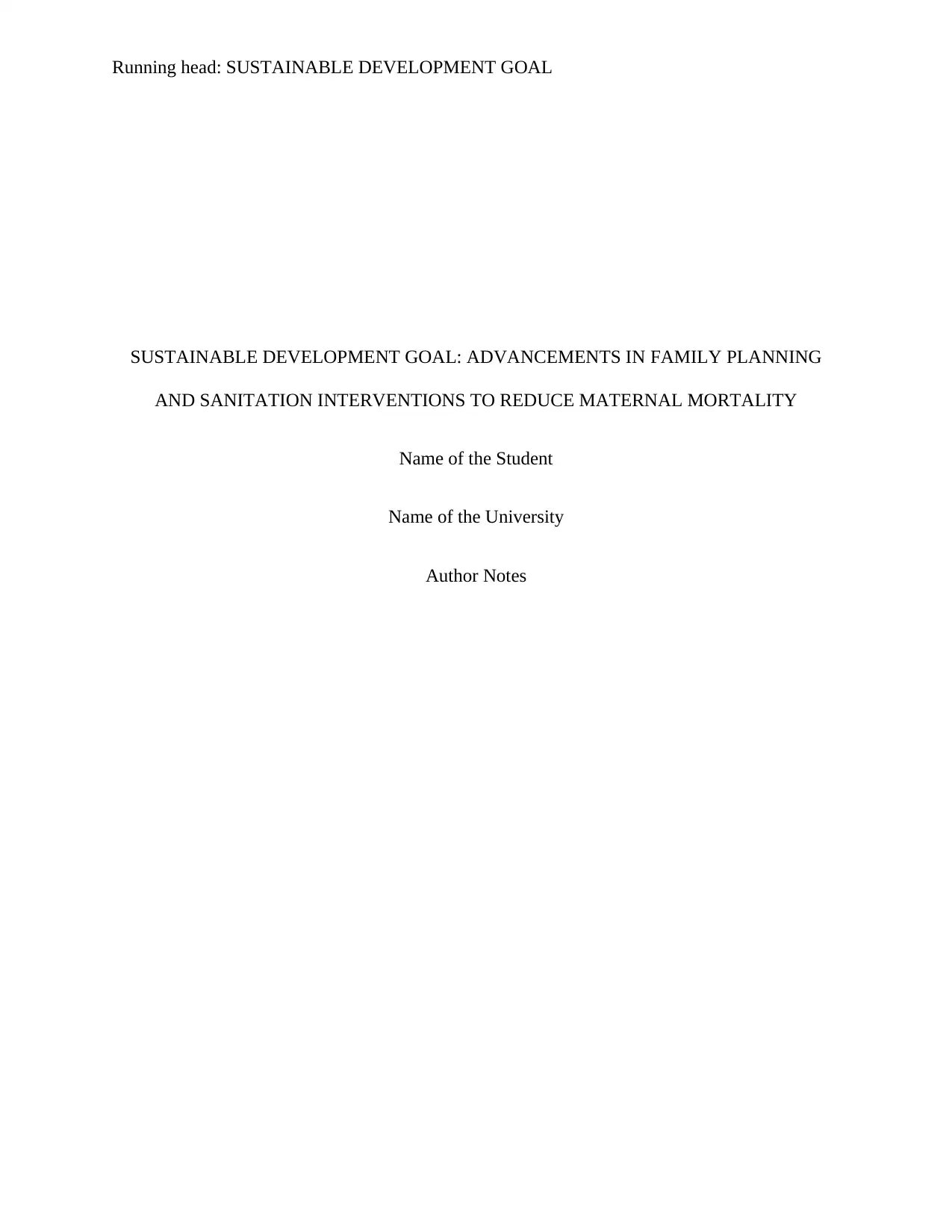
Running head: SUSTAINABLE DEVELOPMENT GOAL
SUSTAINABLE DEVELOPMENT GOAL: ADVANCEMENTS IN FAMILY PLANNING
AND SANITATION INTERVENTIONS TO REDUCE MATERNAL MORTALITY
Name of the Student
Name of the University
Author Notes
SUSTAINABLE DEVELOPMENT GOAL: ADVANCEMENTS IN FAMILY PLANNING
AND SANITATION INTERVENTIONS TO REDUCE MATERNAL MORTALITY
Name of the Student
Name of the University
Author Notes
Paraphrase This Document
Need a fresh take? Get an instant paraphrase of this document with our AI Paraphraser
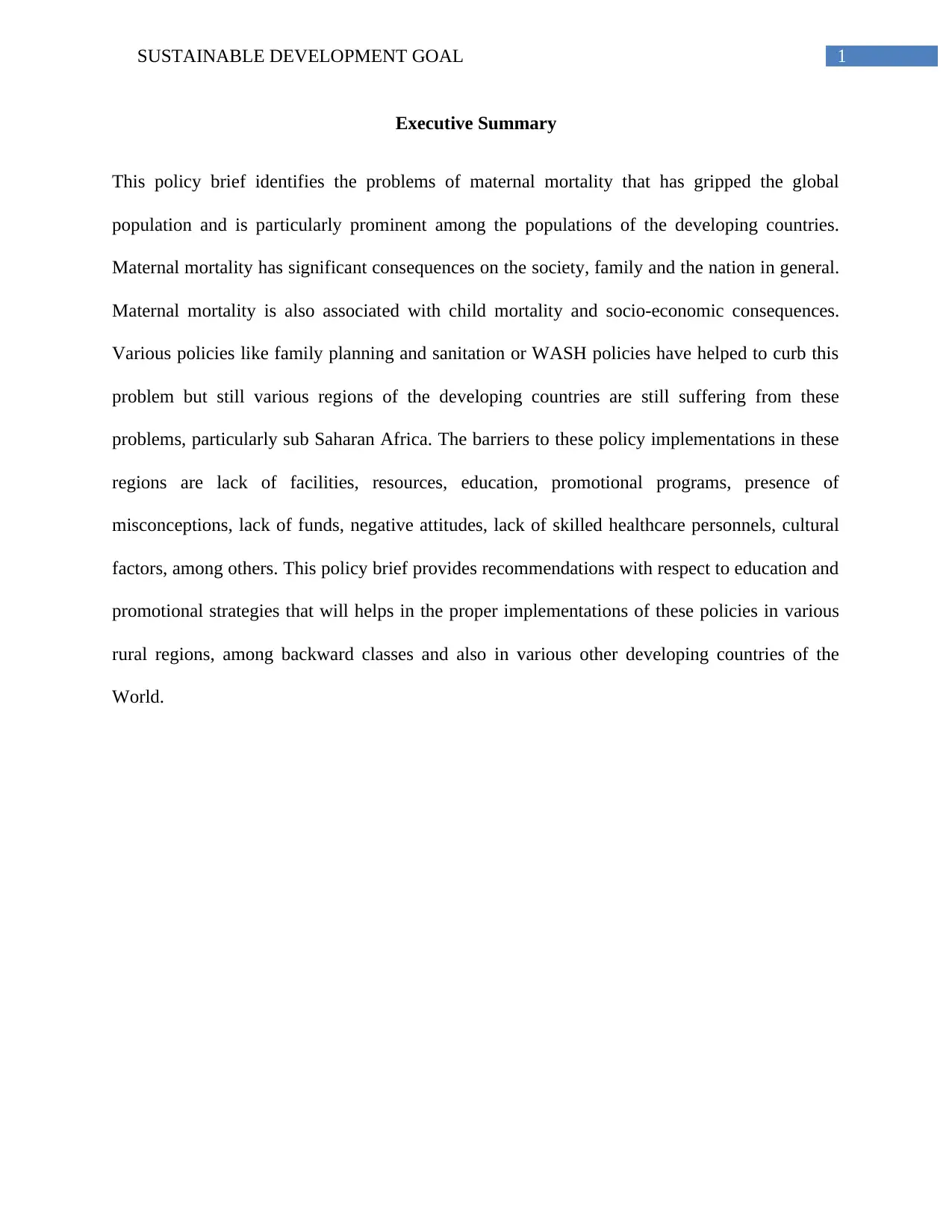
1SUSTAINABLE DEVELOPMENT GOAL
Executive Summary
This policy brief identifies the problems of maternal mortality that has gripped the global
population and is particularly prominent among the populations of the developing countries.
Maternal mortality has significant consequences on the society, family and the nation in general.
Maternal mortality is also associated with child mortality and socio-economic consequences.
Various policies like family planning and sanitation or WASH policies have helped to curb this
problem but still various regions of the developing countries are still suffering from these
problems, particularly sub Saharan Africa. The barriers to these policy implementations in these
regions are lack of facilities, resources, education, promotional programs, presence of
misconceptions, lack of funds, negative attitudes, lack of skilled healthcare personnels, cultural
factors, among others. This policy brief provides recommendations with respect to education and
promotional strategies that will helps in the proper implementations of these policies in various
rural regions, among backward classes and also in various other developing countries of the
World.
Executive Summary
This policy brief identifies the problems of maternal mortality that has gripped the global
population and is particularly prominent among the populations of the developing countries.
Maternal mortality has significant consequences on the society, family and the nation in general.
Maternal mortality is also associated with child mortality and socio-economic consequences.
Various policies like family planning and sanitation or WASH policies have helped to curb this
problem but still various regions of the developing countries are still suffering from these
problems, particularly sub Saharan Africa. The barriers to these policy implementations in these
regions are lack of facilities, resources, education, promotional programs, presence of
misconceptions, lack of funds, negative attitudes, lack of skilled healthcare personnels, cultural
factors, among others. This policy brief provides recommendations with respect to education and
promotional strategies that will helps in the proper implementations of these policies in various
rural regions, among backward classes and also in various other developing countries of the
World.
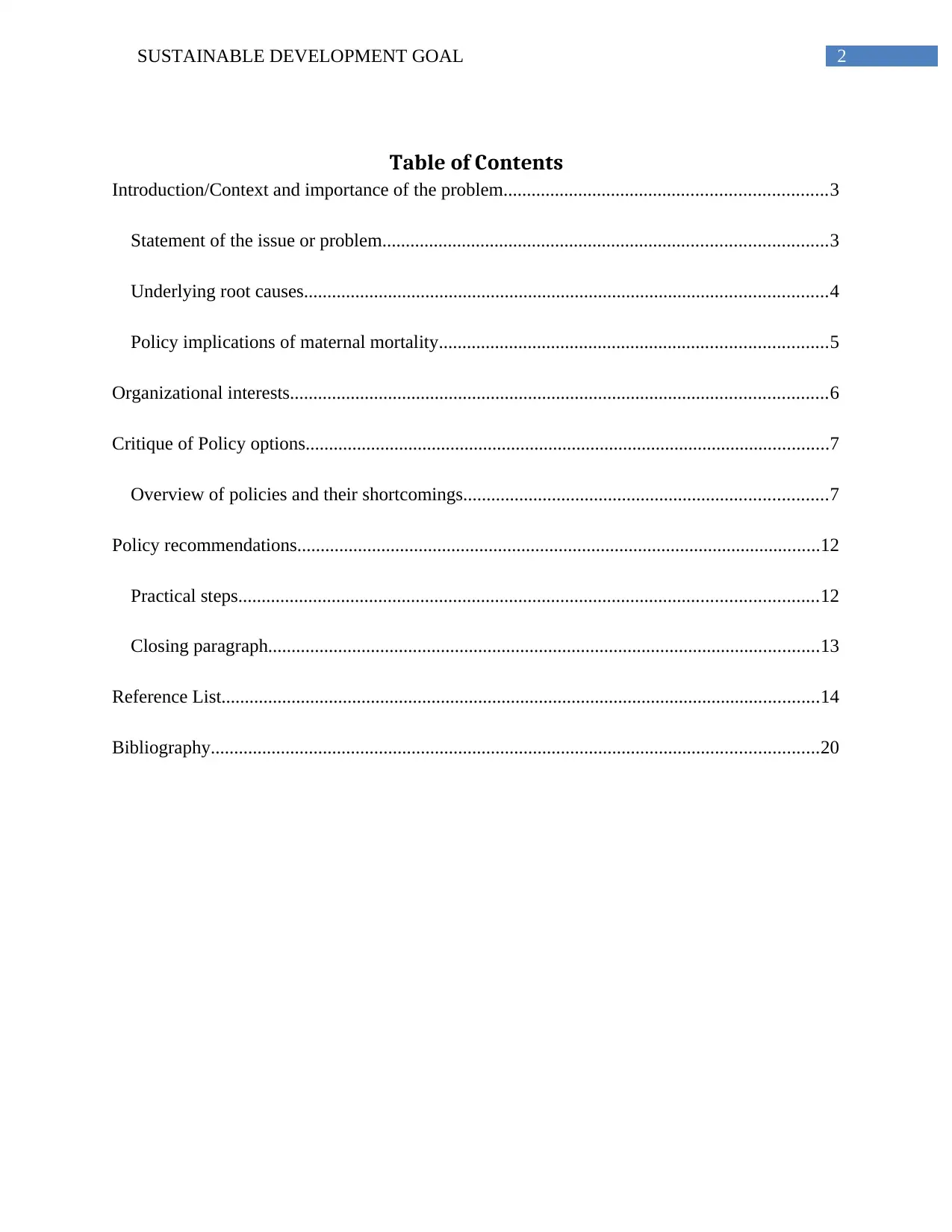
2SUSTAINABLE DEVELOPMENT GOAL
Table of Contents
Introduction/Context and importance of the problem.....................................................................3
Statement of the issue or problem...............................................................................................3
Underlying root causes................................................................................................................4
Policy implications of maternal mortality...................................................................................5
Organizational interests...................................................................................................................6
Critique of Policy options................................................................................................................7
Overview of policies and their shortcomings..............................................................................7
Policy recommendations................................................................................................................12
Practical steps............................................................................................................................12
Closing paragraph......................................................................................................................13
Reference List................................................................................................................................14
Bibliography..................................................................................................................................20
Table of Contents
Introduction/Context and importance of the problem.....................................................................3
Statement of the issue or problem...............................................................................................3
Underlying root causes................................................................................................................4
Policy implications of maternal mortality...................................................................................5
Organizational interests...................................................................................................................6
Critique of Policy options................................................................................................................7
Overview of policies and their shortcomings..............................................................................7
Policy recommendations................................................................................................................12
Practical steps............................................................................................................................12
Closing paragraph......................................................................................................................13
Reference List................................................................................................................................14
Bibliography..................................................................................................................................20
⊘ This is a preview!⊘
Do you want full access?
Subscribe today to unlock all pages.

Trusted by 1+ million students worldwide
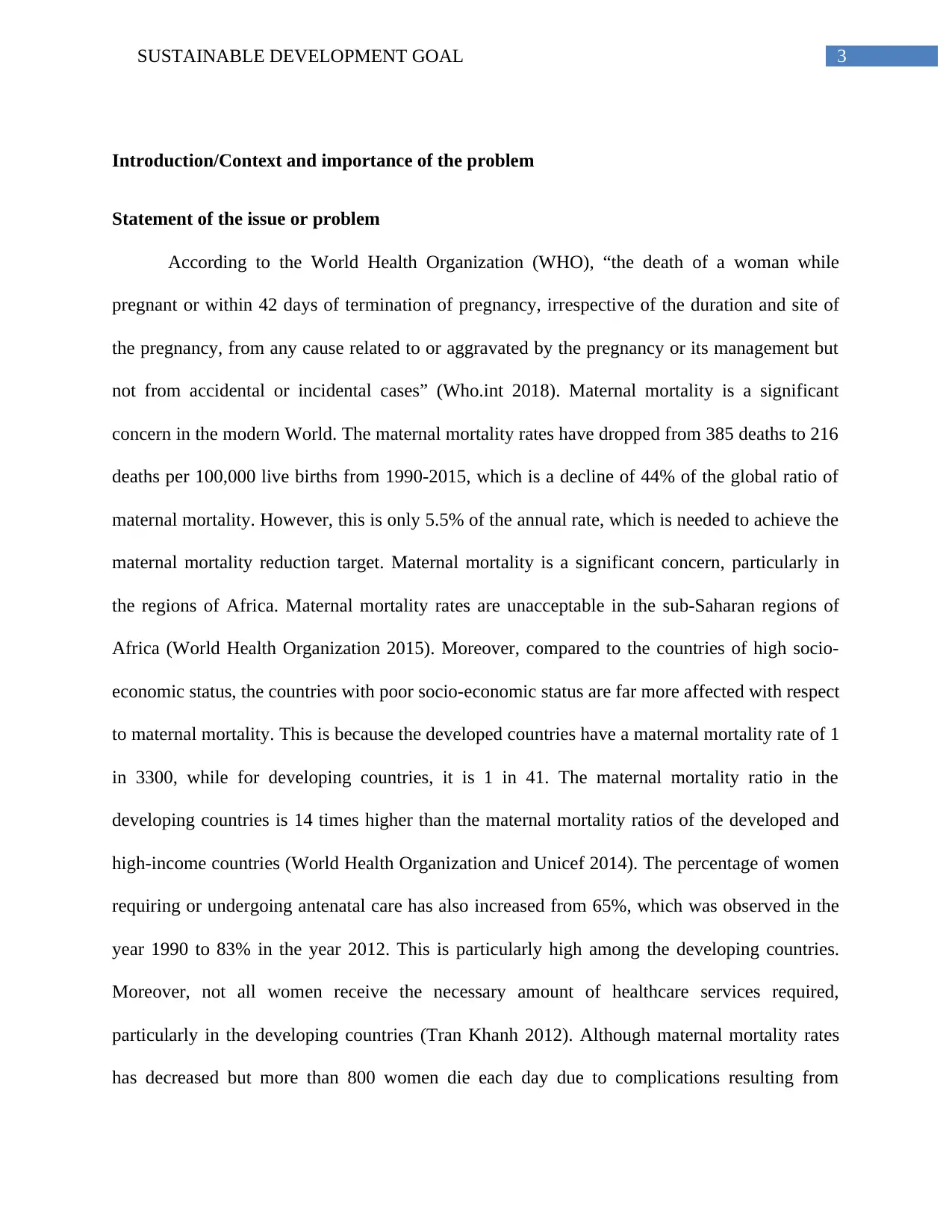
3SUSTAINABLE DEVELOPMENT GOAL
Introduction/Context and importance of the problem
Statement of the issue or problem
According to the World Health Organization (WHO), “the death of a woman while
pregnant or within 42 days of termination of pregnancy, irrespective of the duration and site of
the pregnancy, from any cause related to or aggravated by the pregnancy or its management but
not from accidental or incidental cases” (Who.int 2018). Maternal mortality is a significant
concern in the modern World. The maternal mortality rates have dropped from 385 deaths to 216
deaths per 100,000 live births from 1990-2015, which is a decline of 44% of the global ratio of
maternal mortality. However, this is only 5.5% of the annual rate, which is needed to achieve the
maternal mortality reduction target. Maternal mortality is a significant concern, particularly in
the regions of Africa. Maternal mortality rates are unacceptable in the sub-Saharan regions of
Africa (World Health Organization 2015). Moreover, compared to the countries of high socio-
economic status, the countries with poor socio-economic status are far more affected with respect
to maternal mortality. This is because the developed countries have a maternal mortality rate of 1
in 3300, while for developing countries, it is 1 in 41. The maternal mortality ratio in the
developing countries is 14 times higher than the maternal mortality ratios of the developed and
high-income countries (World Health Organization and Unicef 2014). The percentage of women
requiring or undergoing antenatal care has also increased from 65%, which was observed in the
year 1990 to 83% in the year 2012. This is particularly high among the developing countries.
Moreover, not all women receive the necessary amount of healthcare services required,
particularly in the developing countries (Tran Khanh 2012). Although maternal mortality rates
has decreased but more than 800 women die each day due to complications resulting from
Introduction/Context and importance of the problem
Statement of the issue or problem
According to the World Health Organization (WHO), “the death of a woman while
pregnant or within 42 days of termination of pregnancy, irrespective of the duration and site of
the pregnancy, from any cause related to or aggravated by the pregnancy or its management but
not from accidental or incidental cases” (Who.int 2018). Maternal mortality is a significant
concern in the modern World. The maternal mortality rates have dropped from 385 deaths to 216
deaths per 100,000 live births from 1990-2015, which is a decline of 44% of the global ratio of
maternal mortality. However, this is only 5.5% of the annual rate, which is needed to achieve the
maternal mortality reduction target. Maternal mortality is a significant concern, particularly in
the regions of Africa. Maternal mortality rates are unacceptable in the sub-Saharan regions of
Africa (World Health Organization 2015). Moreover, compared to the countries of high socio-
economic status, the countries with poor socio-economic status are far more affected with respect
to maternal mortality. This is because the developed countries have a maternal mortality rate of 1
in 3300, while for developing countries, it is 1 in 41. The maternal mortality ratio in the
developing countries is 14 times higher than the maternal mortality ratios of the developed and
high-income countries (World Health Organization and Unicef 2014). The percentage of women
requiring or undergoing antenatal care has also increased from 65%, which was observed in the
year 1990 to 83% in the year 2012. This is particularly high among the developing countries.
Moreover, not all women receive the necessary amount of healthcare services required,
particularly in the developing countries (Tran Khanh 2012). Although maternal mortality rates
has decreased but more than 800 women die each day due to complications resulting from
Paraphrase This Document
Need a fresh take? Get an instant paraphrase of this document with our AI Paraphraser
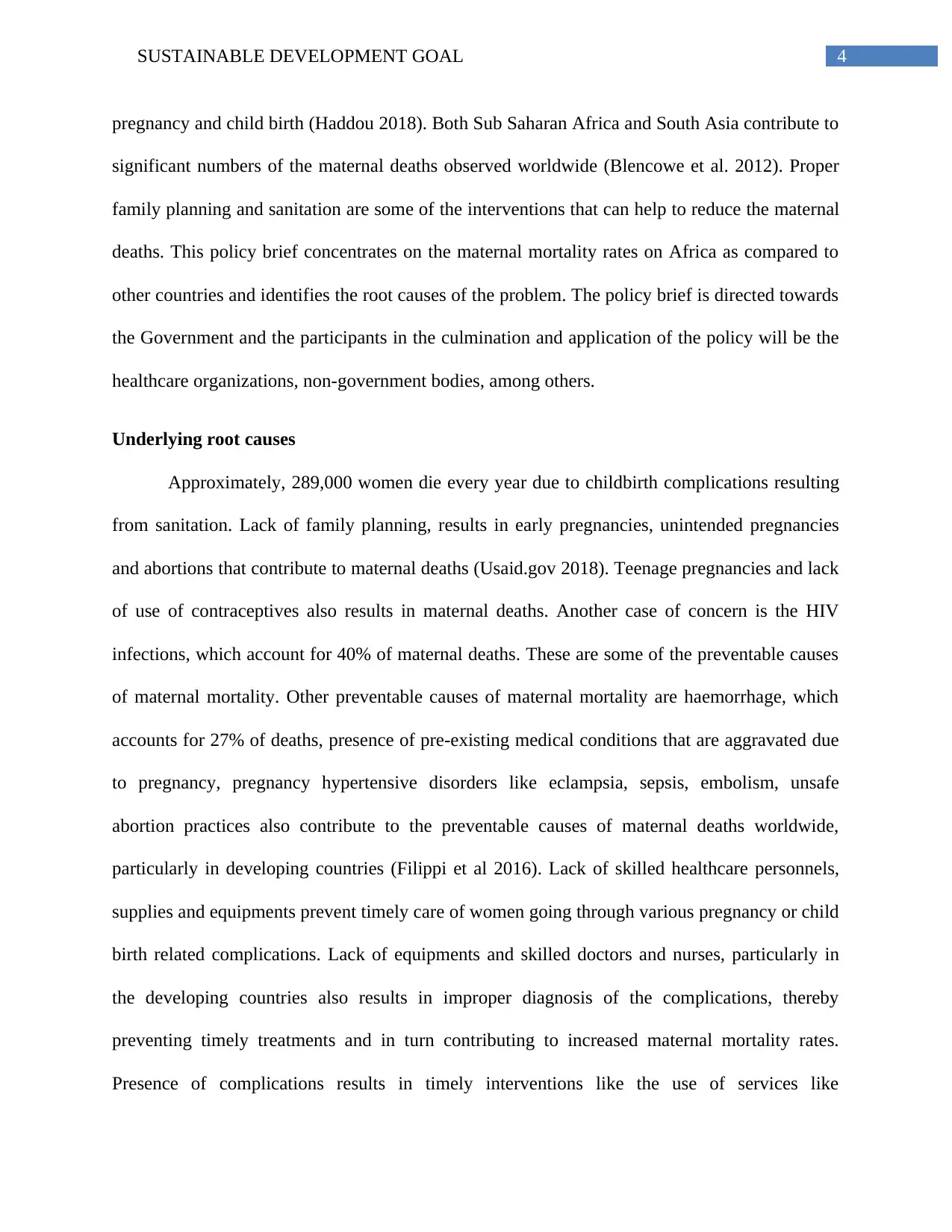
4SUSTAINABLE DEVELOPMENT GOAL
pregnancy and child birth (Haddou 2018). Both Sub Saharan Africa and South Asia contribute to
significant numbers of the maternal deaths observed worldwide (Blencowe et al. 2012). Proper
family planning and sanitation are some of the interventions that can help to reduce the maternal
deaths. This policy brief concentrates on the maternal mortality rates on Africa as compared to
other countries and identifies the root causes of the problem. The policy brief is directed towards
the Government and the participants in the culmination and application of the policy will be the
healthcare organizations, non-government bodies, among others.
Underlying root causes
Approximately, 289,000 women die every year due to childbirth complications resulting
from sanitation. Lack of family planning, results in early pregnancies, unintended pregnancies
and abortions that contribute to maternal deaths (Usaid.gov 2018). Teenage pregnancies and lack
of use of contraceptives also results in maternal deaths. Another case of concern is the HIV
infections, which account for 40% of maternal deaths. These are some of the preventable causes
of maternal mortality. Other preventable causes of maternal mortality are haemorrhage, which
accounts for 27% of deaths, presence of pre-existing medical conditions that are aggravated due
to pregnancy, pregnancy hypertensive disorders like eclampsia, sepsis, embolism, unsafe
abortion practices also contribute to the preventable causes of maternal deaths worldwide,
particularly in developing countries (Filippi et al 2016). Lack of skilled healthcare personnels,
supplies and equipments prevent timely care of women going through various pregnancy or child
birth related complications. Lack of equipments and skilled doctors and nurses, particularly in
the developing countries also results in improper diagnosis of the complications, thereby
preventing timely treatments and in turn contributing to increased maternal mortality rates.
Presence of complications results in timely interventions like the use of services like
pregnancy and child birth (Haddou 2018). Both Sub Saharan Africa and South Asia contribute to
significant numbers of the maternal deaths observed worldwide (Blencowe et al. 2012). Proper
family planning and sanitation are some of the interventions that can help to reduce the maternal
deaths. This policy brief concentrates on the maternal mortality rates on Africa as compared to
other countries and identifies the root causes of the problem. The policy brief is directed towards
the Government and the participants in the culmination and application of the policy will be the
healthcare organizations, non-government bodies, among others.
Underlying root causes
Approximately, 289,000 women die every year due to childbirth complications resulting
from sanitation. Lack of family planning, results in early pregnancies, unintended pregnancies
and abortions that contribute to maternal deaths (Usaid.gov 2018). Teenage pregnancies and lack
of use of contraceptives also results in maternal deaths. Another case of concern is the HIV
infections, which account for 40% of maternal deaths. These are some of the preventable causes
of maternal mortality. Other preventable causes of maternal mortality are haemorrhage, which
accounts for 27% of deaths, presence of pre-existing medical conditions that are aggravated due
to pregnancy, pregnancy hypertensive disorders like eclampsia, sepsis, embolism, unsafe
abortion practices also contribute to the preventable causes of maternal deaths worldwide,
particularly in developing countries (Filippi et al 2016). Lack of skilled healthcare personnels,
supplies and equipments prevent timely care of women going through various pregnancy or child
birth related complications. Lack of equipments and skilled doctors and nurses, particularly in
the developing countries also results in improper diagnosis of the complications, thereby
preventing timely treatments and in turn contributing to increased maternal mortality rates.
Presence of complications results in timely interventions like the use of services like
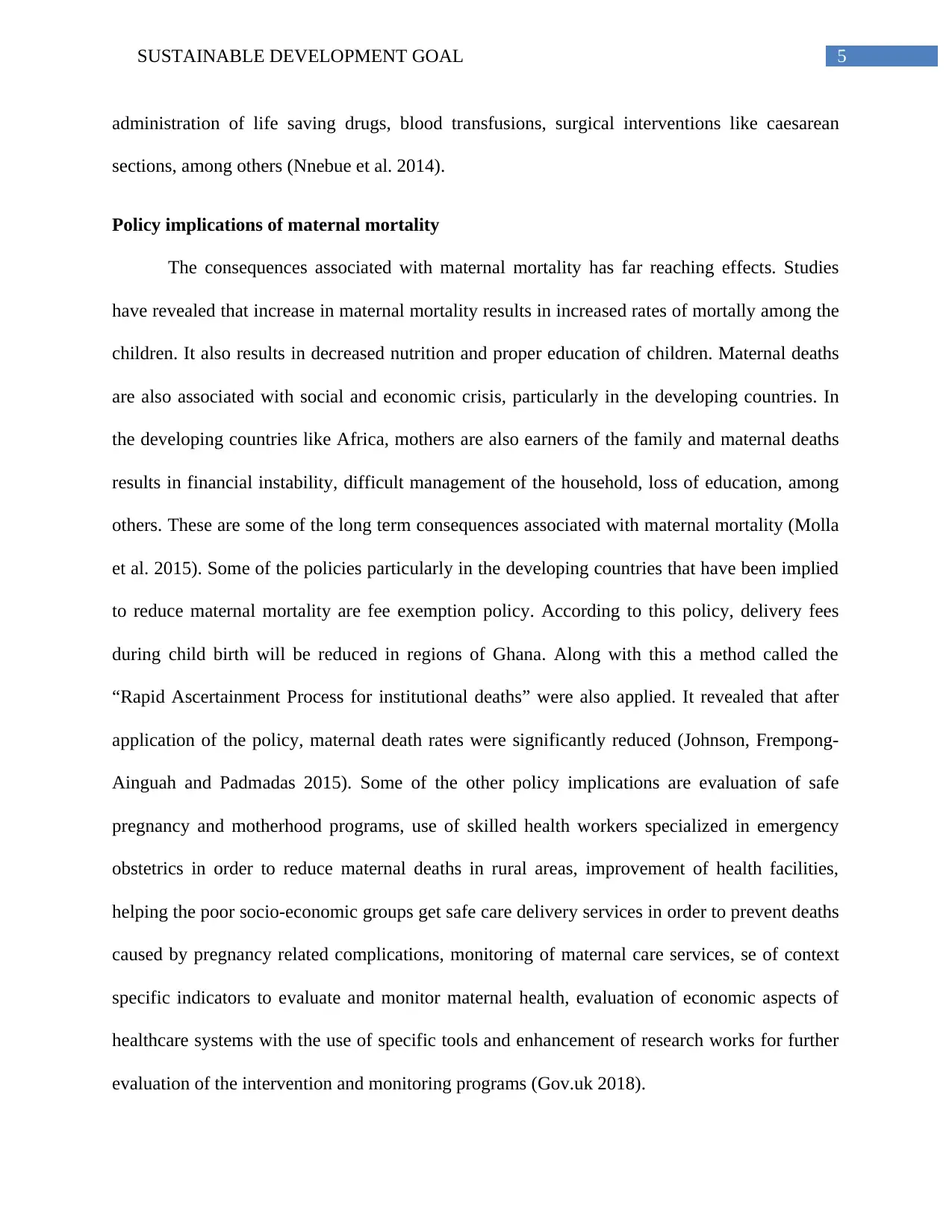
5SUSTAINABLE DEVELOPMENT GOAL
administration of life saving drugs, blood transfusions, surgical interventions like caesarean
sections, among others (Nnebue et al. 2014).
Policy implications of maternal mortality
The consequences associated with maternal mortality has far reaching effects. Studies
have revealed that increase in maternal mortality results in increased rates of mortally among the
children. It also results in decreased nutrition and proper education of children. Maternal deaths
are also associated with social and economic crisis, particularly in the developing countries. In
the developing countries like Africa, mothers are also earners of the family and maternal deaths
results in financial instability, difficult management of the household, loss of education, among
others. These are some of the long term consequences associated with maternal mortality (Molla
et al. 2015). Some of the policies particularly in the developing countries that have been implied
to reduce maternal mortality are fee exemption policy. According to this policy, delivery fees
during child birth will be reduced in regions of Ghana. Along with this a method called the
“Rapid Ascertainment Process for institutional deaths” were also applied. It revealed that after
application of the policy, maternal death rates were significantly reduced (Johnson, Frempong-
Ainguah and Padmadas 2015). Some of the other policy implications are evaluation of safe
pregnancy and motherhood programs, use of skilled health workers specialized in emergency
obstetrics in order to reduce maternal deaths in rural areas, improvement of health facilities,
helping the poor socio-economic groups get safe care delivery services in order to prevent deaths
caused by pregnancy related complications, monitoring of maternal care services, se of context
specific indicators to evaluate and monitor maternal health, evaluation of economic aspects of
healthcare systems with the use of specific tools and enhancement of research works for further
evaluation of the intervention and monitoring programs (Gov.uk 2018).
administration of life saving drugs, blood transfusions, surgical interventions like caesarean
sections, among others (Nnebue et al. 2014).
Policy implications of maternal mortality
The consequences associated with maternal mortality has far reaching effects. Studies
have revealed that increase in maternal mortality results in increased rates of mortally among the
children. It also results in decreased nutrition and proper education of children. Maternal deaths
are also associated with social and economic crisis, particularly in the developing countries. In
the developing countries like Africa, mothers are also earners of the family and maternal deaths
results in financial instability, difficult management of the household, loss of education, among
others. These are some of the long term consequences associated with maternal mortality (Molla
et al. 2015). Some of the policies particularly in the developing countries that have been implied
to reduce maternal mortality are fee exemption policy. According to this policy, delivery fees
during child birth will be reduced in regions of Ghana. Along with this a method called the
“Rapid Ascertainment Process for institutional deaths” were also applied. It revealed that after
application of the policy, maternal death rates were significantly reduced (Johnson, Frempong-
Ainguah and Padmadas 2015). Some of the other policy implications are evaluation of safe
pregnancy and motherhood programs, use of skilled health workers specialized in emergency
obstetrics in order to reduce maternal deaths in rural areas, improvement of health facilities,
helping the poor socio-economic groups get safe care delivery services in order to prevent deaths
caused by pregnancy related complications, monitoring of maternal care services, se of context
specific indicators to evaluate and monitor maternal health, evaluation of economic aspects of
healthcare systems with the use of specific tools and enhancement of research works for further
evaluation of the intervention and monitoring programs (Gov.uk 2018).
⊘ This is a preview!⊘
Do you want full access?
Subscribe today to unlock all pages.

Trusted by 1+ million students worldwide
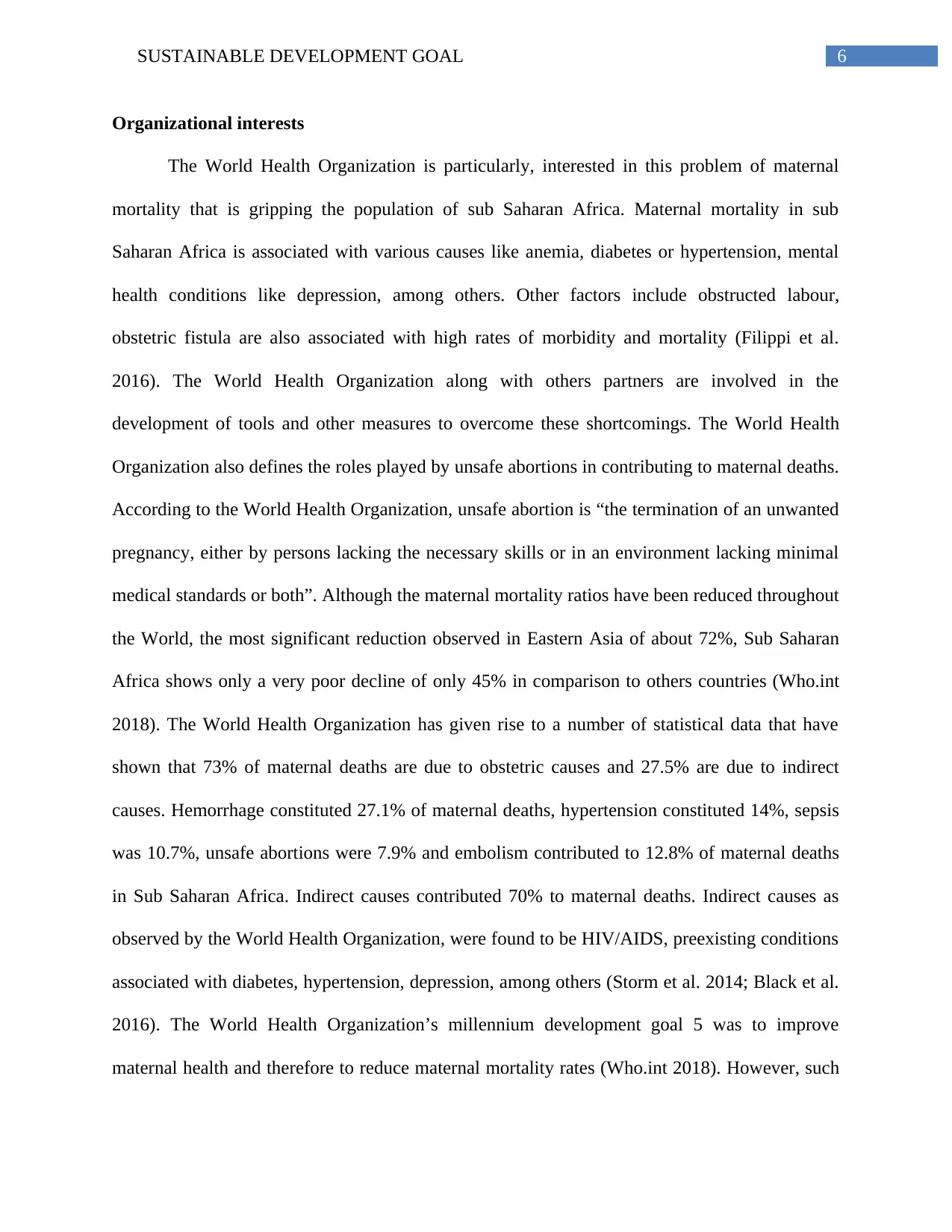
6SUSTAINABLE DEVELOPMENT GOAL
Organizational interests
The World Health Organization is particularly, interested in this problem of maternal
mortality that is gripping the population of sub Saharan Africa. Maternal mortality in sub
Saharan Africa is associated with various causes like anemia, diabetes or hypertension, mental
health conditions like depression, among others. Other factors include obstructed labour,
obstetric fistula are also associated with high rates of morbidity and mortality (Filippi et al.
2016). The World Health Organization along with others partners are involved in the
development of tools and other measures to overcome these shortcomings. The World Health
Organization also defines the roles played by unsafe abortions in contributing to maternal deaths.
According to the World Health Organization, unsafe abortion is “the termination of an unwanted
pregnancy, either by persons lacking the necessary skills or in an environment lacking minimal
medical standards or both”. Although the maternal mortality ratios have been reduced throughout
the World, the most significant reduction observed in Eastern Asia of about 72%, Sub Saharan
Africa shows only a very poor decline of only 45% in comparison to others countries (Who.int
2018). The World Health Organization has given rise to a number of statistical data that have
shown that 73% of maternal deaths are due to obstetric causes and 27.5% are due to indirect
causes. Hemorrhage constituted 27.1% of maternal deaths, hypertension constituted 14%, sepsis
was 10.7%, unsafe abortions were 7.9% and embolism contributed to 12.8% of maternal deaths
in Sub Saharan Africa. Indirect causes contributed 70% to maternal deaths. Indirect causes as
observed by the World Health Organization, were found to be HIV/AIDS, preexisting conditions
associated with diabetes, hypertension, depression, among others (Storm et al. 2014; Black et al.
2016). The World Health Organization’s millennium development goal 5 was to improve
maternal health and therefore to reduce maternal mortality rates (Who.int 2018). However, such
Organizational interests
The World Health Organization is particularly, interested in this problem of maternal
mortality that is gripping the population of sub Saharan Africa. Maternal mortality in sub
Saharan Africa is associated with various causes like anemia, diabetes or hypertension, mental
health conditions like depression, among others. Other factors include obstructed labour,
obstetric fistula are also associated with high rates of morbidity and mortality (Filippi et al.
2016). The World Health Organization along with others partners are involved in the
development of tools and other measures to overcome these shortcomings. The World Health
Organization also defines the roles played by unsafe abortions in contributing to maternal deaths.
According to the World Health Organization, unsafe abortion is “the termination of an unwanted
pregnancy, either by persons lacking the necessary skills or in an environment lacking minimal
medical standards or both”. Although the maternal mortality ratios have been reduced throughout
the World, the most significant reduction observed in Eastern Asia of about 72%, Sub Saharan
Africa shows only a very poor decline of only 45% in comparison to others countries (Who.int
2018). The World Health Organization has given rise to a number of statistical data that have
shown that 73% of maternal deaths are due to obstetric causes and 27.5% are due to indirect
causes. Hemorrhage constituted 27.1% of maternal deaths, hypertension constituted 14%, sepsis
was 10.7%, unsafe abortions were 7.9% and embolism contributed to 12.8% of maternal deaths
in Sub Saharan Africa. Indirect causes contributed 70% to maternal deaths. Indirect causes as
observed by the World Health Organization, were found to be HIV/AIDS, preexisting conditions
associated with diabetes, hypertension, depression, among others (Storm et al. 2014; Black et al.
2016). The World Health Organization’s millennium development goal 5 was to improve
maternal health and therefore to reduce maternal mortality rates (Who.int 2018). However, such
Paraphrase This Document
Need a fresh take? Get an instant paraphrase of this document with our AI Paraphraser
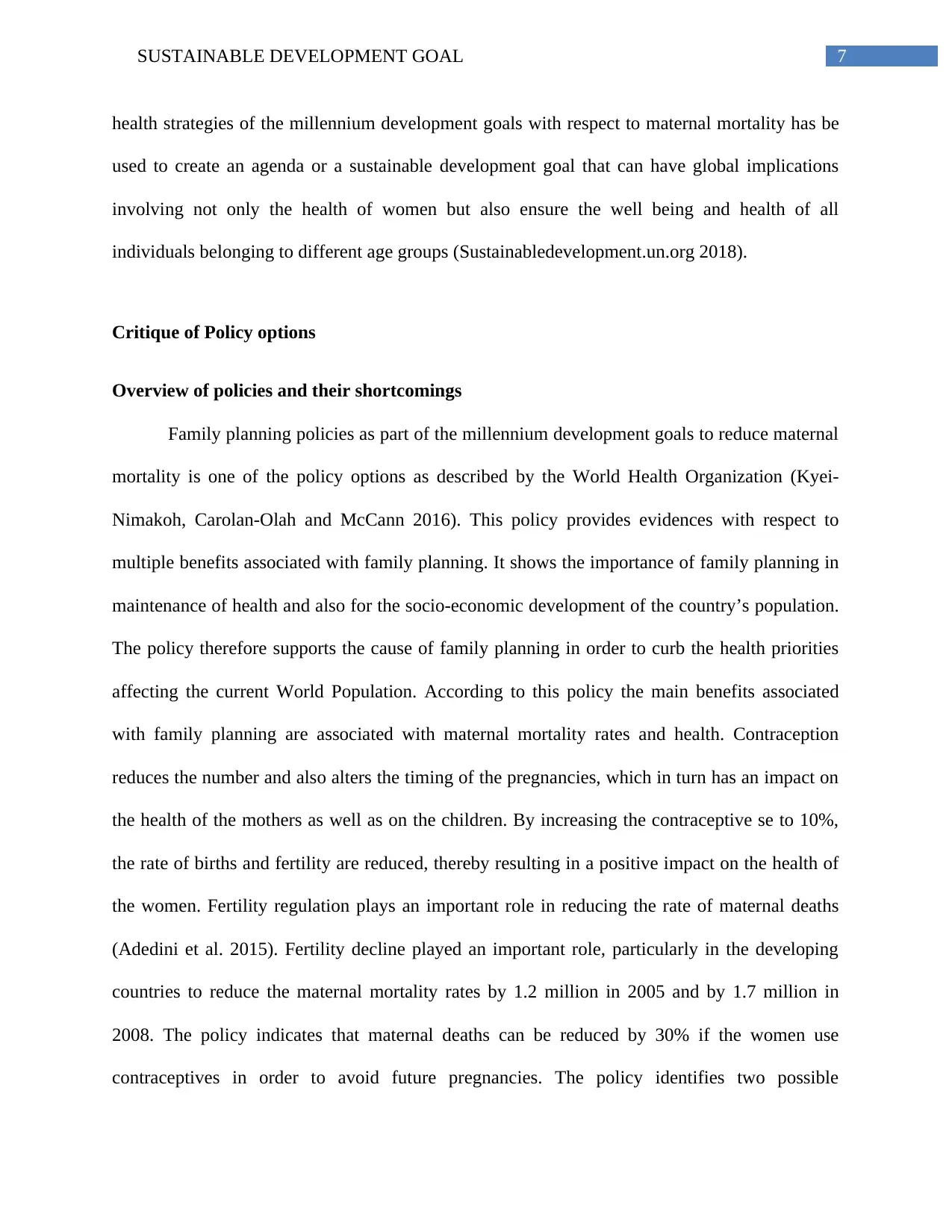
7SUSTAINABLE DEVELOPMENT GOAL
health strategies of the millennium development goals with respect to maternal mortality has be
used to create an agenda or a sustainable development goal that can have global implications
involving not only the health of women but also ensure the well being and health of all
individuals belonging to different age groups (Sustainabledevelopment.un.org 2018).
Critique of Policy options
Overview of policies and their shortcomings
Family planning policies as part of the millennium development goals to reduce maternal
mortality is one of the policy options as described by the World Health Organization (Kyei-
Nimakoh, Carolan-Olah and McCann 2016). This policy provides evidences with respect to
multiple benefits associated with family planning. It shows the importance of family planning in
maintenance of health and also for the socio-economic development of the country’s population.
The policy therefore supports the cause of family planning in order to curb the health priorities
affecting the current World Population. According to this policy the main benefits associated
with family planning are associated with maternal mortality rates and health. Contraception
reduces the number and also alters the timing of the pregnancies, which in turn has an impact on
the health of the mothers as well as on the children. By increasing the contraceptive se to 10%,
the rate of births and fertility are reduced, thereby resulting in a positive impact on the health of
the women. Fertility regulation plays an important role in reducing the rate of maternal deaths
(Adedini et al. 2015). Fertility decline played an important role, particularly in the developing
countries to reduce the maternal mortality rates by 1.2 million in 2005 and by 1.7 million in
2008. The policy indicates that maternal deaths can be reduced by 30% if the women use
contraceptives in order to avoid future pregnancies. The policy identifies two possible
health strategies of the millennium development goals with respect to maternal mortality has be
used to create an agenda or a sustainable development goal that can have global implications
involving not only the health of women but also ensure the well being and health of all
individuals belonging to different age groups (Sustainabledevelopment.un.org 2018).
Critique of Policy options
Overview of policies and their shortcomings
Family planning policies as part of the millennium development goals to reduce maternal
mortality is one of the policy options as described by the World Health Organization (Kyei-
Nimakoh, Carolan-Olah and McCann 2016). This policy provides evidences with respect to
multiple benefits associated with family planning. It shows the importance of family planning in
maintenance of health and also for the socio-economic development of the country’s population.
The policy therefore supports the cause of family planning in order to curb the health priorities
affecting the current World Population. According to this policy the main benefits associated
with family planning are associated with maternal mortality rates and health. Contraception
reduces the number and also alters the timing of the pregnancies, which in turn has an impact on
the health of the mothers as well as on the children. By increasing the contraceptive se to 10%,
the rate of births and fertility are reduced, thereby resulting in a positive impact on the health of
the women. Fertility regulation plays an important role in reducing the rate of maternal deaths
(Adedini et al. 2015). Fertility decline played an important role, particularly in the developing
countries to reduce the maternal mortality rates by 1.2 million in 2005 and by 1.7 million in
2008. The policy indicates that maternal deaths can be reduced by 30% if the women use
contraceptives in order to avoid future pregnancies. The policy identifies two possible
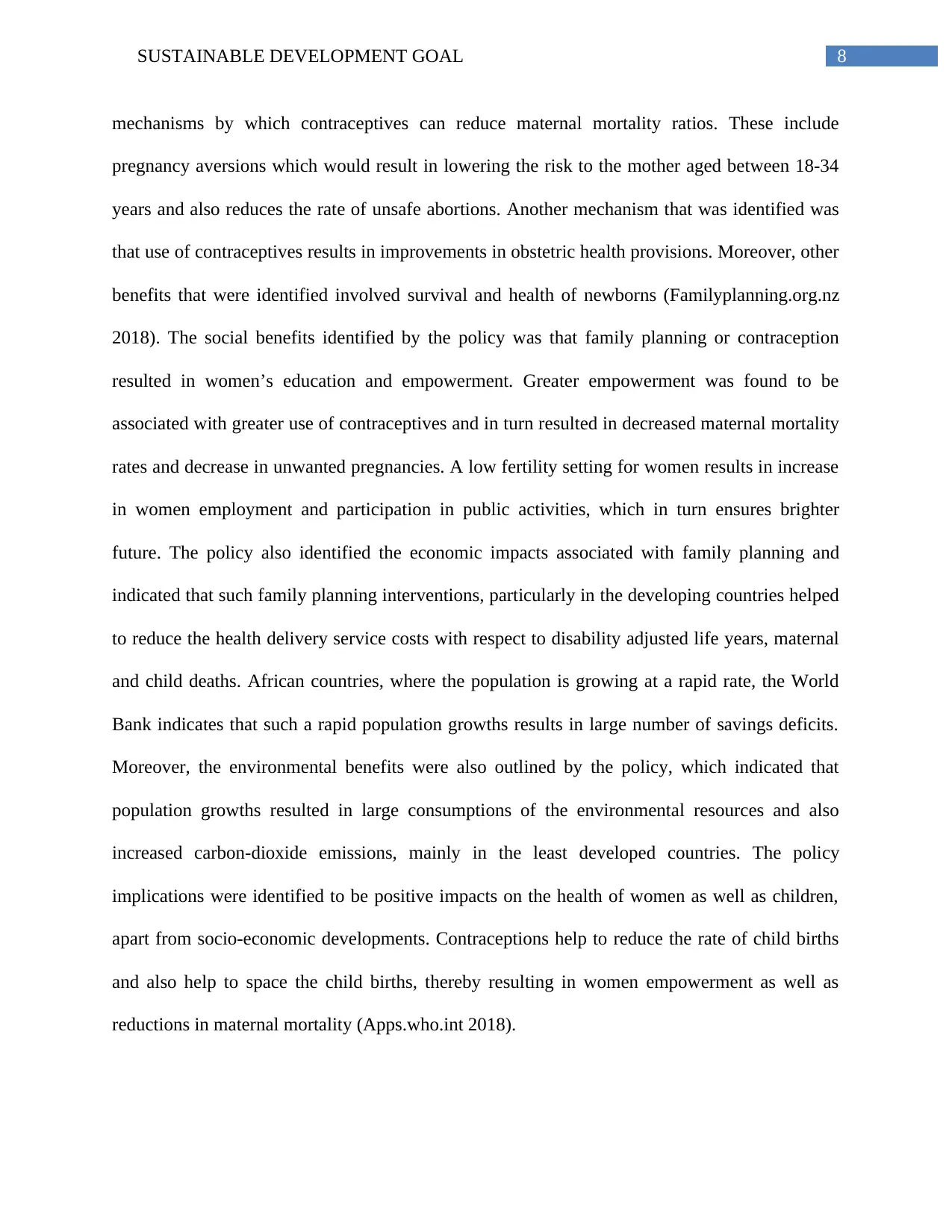
8SUSTAINABLE DEVELOPMENT GOAL
mechanisms by which contraceptives can reduce maternal mortality ratios. These include
pregnancy aversions which would result in lowering the risk to the mother aged between 18-34
years and also reduces the rate of unsafe abortions. Another mechanism that was identified was
that use of contraceptives results in improvements in obstetric health provisions. Moreover, other
benefits that were identified involved survival and health of newborns (Familyplanning.org.nz
2018). The social benefits identified by the policy was that family planning or contraception
resulted in women’s education and empowerment. Greater empowerment was found to be
associated with greater use of contraceptives and in turn resulted in decreased maternal mortality
rates and decrease in unwanted pregnancies. A low fertility setting for women results in increase
in women employment and participation in public activities, which in turn ensures brighter
future. The policy also identified the economic impacts associated with family planning and
indicated that such family planning interventions, particularly in the developing countries helped
to reduce the health delivery service costs with respect to disability adjusted life years, maternal
and child deaths. African countries, where the population is growing at a rapid rate, the World
Bank indicates that such a rapid population growths results in large number of savings deficits.
Moreover, the environmental benefits were also outlined by the policy, which indicated that
population growths resulted in large consumptions of the environmental resources and also
increased carbon-dioxide emissions, mainly in the least developed countries. The policy
implications were identified to be positive impacts on the health of women as well as children,
apart from socio-economic developments. Contraceptions help to reduce the rate of child births
and also help to space the child births, thereby resulting in women empowerment as well as
reductions in maternal mortality (Apps.who.int 2018).
mechanisms by which contraceptives can reduce maternal mortality ratios. These include
pregnancy aversions which would result in lowering the risk to the mother aged between 18-34
years and also reduces the rate of unsafe abortions. Another mechanism that was identified was
that use of contraceptives results in improvements in obstetric health provisions. Moreover, other
benefits that were identified involved survival and health of newborns (Familyplanning.org.nz
2018). The social benefits identified by the policy was that family planning or contraception
resulted in women’s education and empowerment. Greater empowerment was found to be
associated with greater use of contraceptives and in turn resulted in decreased maternal mortality
rates and decrease in unwanted pregnancies. A low fertility setting for women results in increase
in women employment and participation in public activities, which in turn ensures brighter
future. The policy also identified the economic impacts associated with family planning and
indicated that such family planning interventions, particularly in the developing countries helped
to reduce the health delivery service costs with respect to disability adjusted life years, maternal
and child deaths. African countries, where the population is growing at a rapid rate, the World
Bank indicates that such a rapid population growths results in large number of savings deficits.
Moreover, the environmental benefits were also outlined by the policy, which indicated that
population growths resulted in large consumptions of the environmental resources and also
increased carbon-dioxide emissions, mainly in the least developed countries. The policy
implications were identified to be positive impacts on the health of women as well as children,
apart from socio-economic developments. Contraceptions help to reduce the rate of child births
and also help to space the child births, thereby resulting in women empowerment as well as
reductions in maternal mortality (Apps.who.int 2018).
⊘ This is a preview!⊘
Do you want full access?
Subscribe today to unlock all pages.

Trusted by 1+ million students worldwide
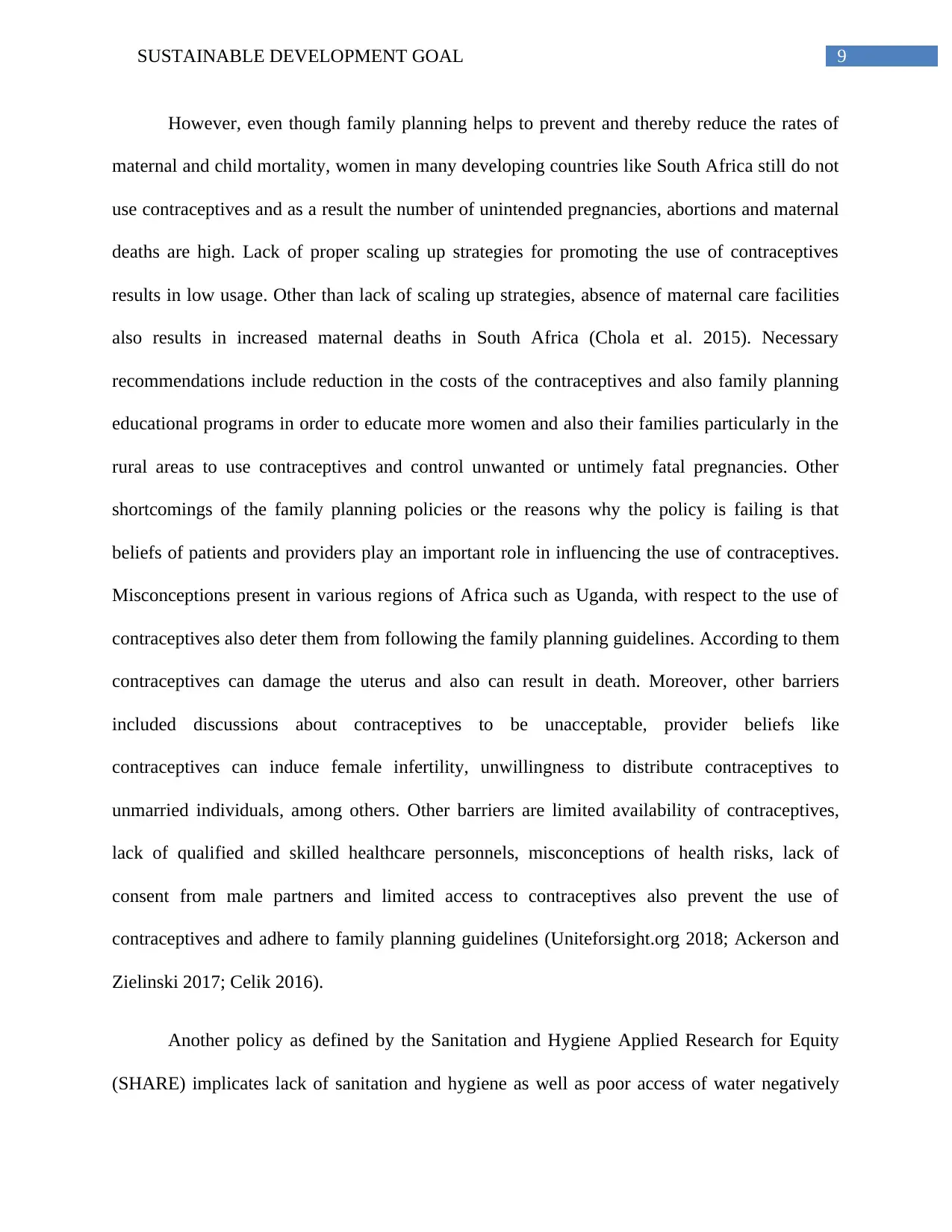
9SUSTAINABLE DEVELOPMENT GOAL
However, even though family planning helps to prevent and thereby reduce the rates of
maternal and child mortality, women in many developing countries like South Africa still do not
use contraceptives and as a result the number of unintended pregnancies, abortions and maternal
deaths are high. Lack of proper scaling up strategies for promoting the use of contraceptives
results in low usage. Other than lack of scaling up strategies, absence of maternal care facilities
also results in increased maternal deaths in South Africa (Chola et al. 2015). Necessary
recommendations include reduction in the costs of the contraceptives and also family planning
educational programs in order to educate more women and also their families particularly in the
rural areas to use contraceptives and control unwanted or untimely fatal pregnancies. Other
shortcomings of the family planning policies or the reasons why the policy is failing is that
beliefs of patients and providers play an important role in influencing the use of contraceptives.
Misconceptions present in various regions of Africa such as Uganda, with respect to the use of
contraceptives also deter them from following the family planning guidelines. According to them
contraceptives can damage the uterus and also can result in death. Moreover, other barriers
included discussions about contraceptives to be unacceptable, provider beliefs like
contraceptives can induce female infertility, unwillingness to distribute contraceptives to
unmarried individuals, among others. Other barriers are limited availability of contraceptives,
lack of qualified and skilled healthcare personnels, misconceptions of health risks, lack of
consent from male partners and limited access to contraceptives also prevent the use of
contraceptives and adhere to family planning guidelines (Uniteforsight.org 2018; Ackerson and
Zielinski 2017; Celik 2016).
Another policy as defined by the Sanitation and Hygiene Applied Research for Equity
(SHARE) implicates lack of sanitation and hygiene as well as poor access of water negatively
However, even though family planning helps to prevent and thereby reduce the rates of
maternal and child mortality, women in many developing countries like South Africa still do not
use contraceptives and as a result the number of unintended pregnancies, abortions and maternal
deaths are high. Lack of proper scaling up strategies for promoting the use of contraceptives
results in low usage. Other than lack of scaling up strategies, absence of maternal care facilities
also results in increased maternal deaths in South Africa (Chola et al. 2015). Necessary
recommendations include reduction in the costs of the contraceptives and also family planning
educational programs in order to educate more women and also their families particularly in the
rural areas to use contraceptives and control unwanted or untimely fatal pregnancies. Other
shortcomings of the family planning policies or the reasons why the policy is failing is that
beliefs of patients and providers play an important role in influencing the use of contraceptives.
Misconceptions present in various regions of Africa such as Uganda, with respect to the use of
contraceptives also deter them from following the family planning guidelines. According to them
contraceptives can damage the uterus and also can result in death. Moreover, other barriers
included discussions about contraceptives to be unacceptable, provider beliefs like
contraceptives can induce female infertility, unwillingness to distribute contraceptives to
unmarried individuals, among others. Other barriers are limited availability of contraceptives,
lack of qualified and skilled healthcare personnels, misconceptions of health risks, lack of
consent from male partners and limited access to contraceptives also prevent the use of
contraceptives and adhere to family planning guidelines (Uniteforsight.org 2018; Ackerson and
Zielinski 2017; Celik 2016).
Another policy as defined by the Sanitation and Hygiene Applied Research for Equity
(SHARE) implicates lack of sanitation and hygiene as well as poor access of water negatively
Paraphrase This Document
Need a fresh take? Get an instant paraphrase of this document with our AI Paraphraser
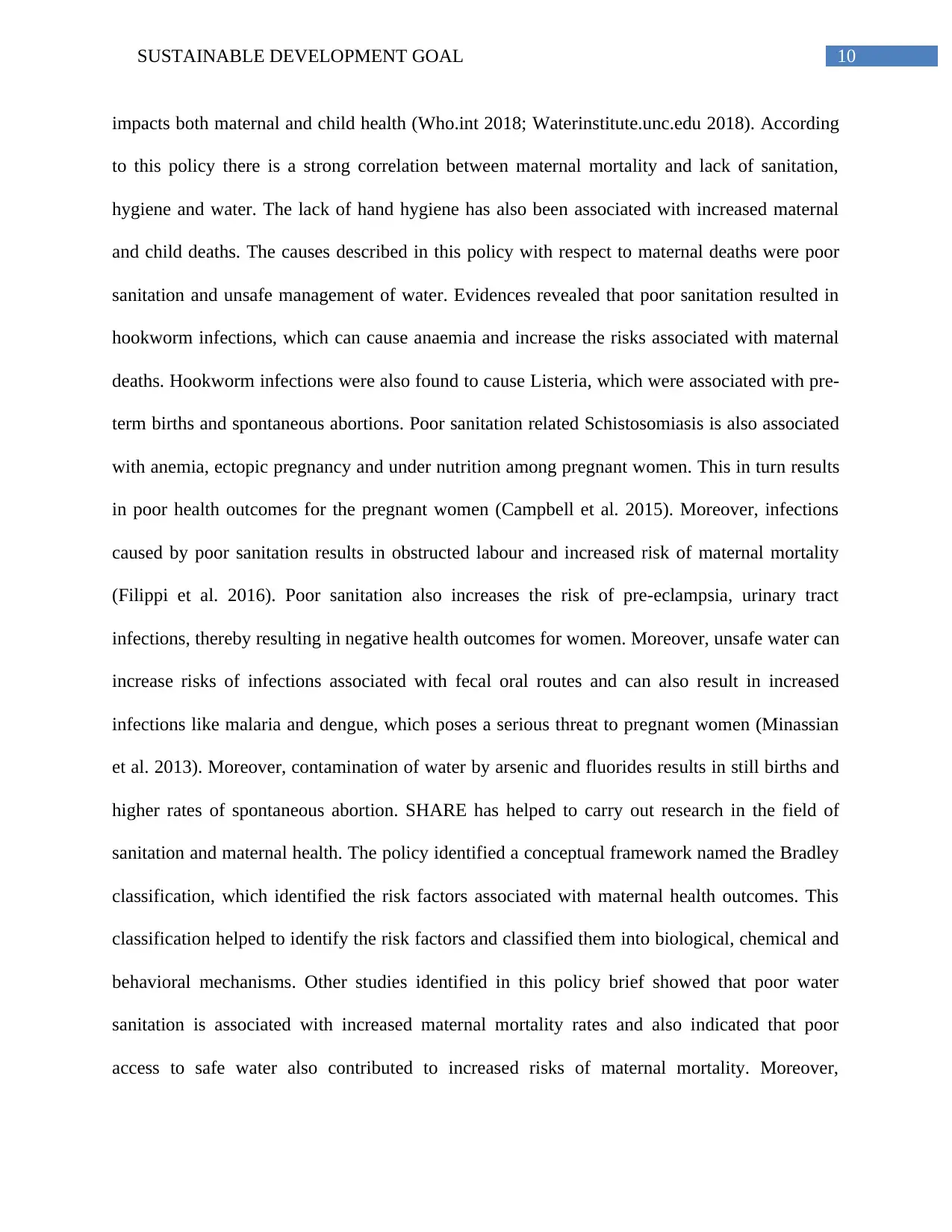
10SUSTAINABLE DEVELOPMENT GOAL
impacts both maternal and child health (Who.int 2018; Waterinstitute.unc.edu 2018). According
to this policy there is a strong correlation between maternal mortality and lack of sanitation,
hygiene and water. The lack of hand hygiene has also been associated with increased maternal
and child deaths. The causes described in this policy with respect to maternal deaths were poor
sanitation and unsafe management of water. Evidences revealed that poor sanitation resulted in
hookworm infections, which can cause anaemia and increase the risks associated with maternal
deaths. Hookworm infections were also found to cause Listeria, which were associated with pre-
term births and spontaneous abortions. Poor sanitation related Schistosomiasis is also associated
with anemia, ectopic pregnancy and under nutrition among pregnant women. This in turn results
in poor health outcomes for the pregnant women (Campbell et al. 2015). Moreover, infections
caused by poor sanitation results in obstructed labour and increased risk of maternal mortality
(Filippi et al. 2016). Poor sanitation also increases the risk of pre-eclampsia, urinary tract
infections, thereby resulting in negative health outcomes for women. Moreover, unsafe water can
increase risks of infections associated with fecal oral routes and can also result in increased
infections like malaria and dengue, which poses a serious threat to pregnant women (Minassian
et al. 2013). Moreover, contamination of water by arsenic and fluorides results in still births and
higher rates of spontaneous abortion. SHARE has helped to carry out research in the field of
sanitation and maternal health. The policy identified a conceptual framework named the Bradley
classification, which identified the risk factors associated with maternal health outcomes. This
classification helped to identify the risk factors and classified them into biological, chemical and
behavioral mechanisms. Other studies identified in this policy brief showed that poor water
sanitation is associated with increased maternal mortality rates and also indicated that poor
access to safe water also contributed to increased risks of maternal mortality. Moreover,
impacts both maternal and child health (Who.int 2018; Waterinstitute.unc.edu 2018). According
to this policy there is a strong correlation between maternal mortality and lack of sanitation,
hygiene and water. The lack of hand hygiene has also been associated with increased maternal
and child deaths. The causes described in this policy with respect to maternal deaths were poor
sanitation and unsafe management of water. Evidences revealed that poor sanitation resulted in
hookworm infections, which can cause anaemia and increase the risks associated with maternal
deaths. Hookworm infections were also found to cause Listeria, which were associated with pre-
term births and spontaneous abortions. Poor sanitation related Schistosomiasis is also associated
with anemia, ectopic pregnancy and under nutrition among pregnant women. This in turn results
in poor health outcomes for the pregnant women (Campbell et al. 2015). Moreover, infections
caused by poor sanitation results in obstructed labour and increased risk of maternal mortality
(Filippi et al. 2016). Poor sanitation also increases the risk of pre-eclampsia, urinary tract
infections, thereby resulting in negative health outcomes for women. Moreover, unsafe water can
increase risks of infections associated with fecal oral routes and can also result in increased
infections like malaria and dengue, which poses a serious threat to pregnant women (Minassian
et al. 2013). Moreover, contamination of water by arsenic and fluorides results in still births and
higher rates of spontaneous abortion. SHARE has helped to carry out research in the field of
sanitation and maternal health. The policy identified a conceptual framework named the Bradley
classification, which identified the risk factors associated with maternal health outcomes. This
classification helped to identify the risk factors and classified them into biological, chemical and
behavioral mechanisms. Other studies identified in this policy brief showed that poor water
sanitation is associated with increased maternal mortality rates and also indicated that poor
access to safe water also contributed to increased risks of maternal mortality. Moreover,
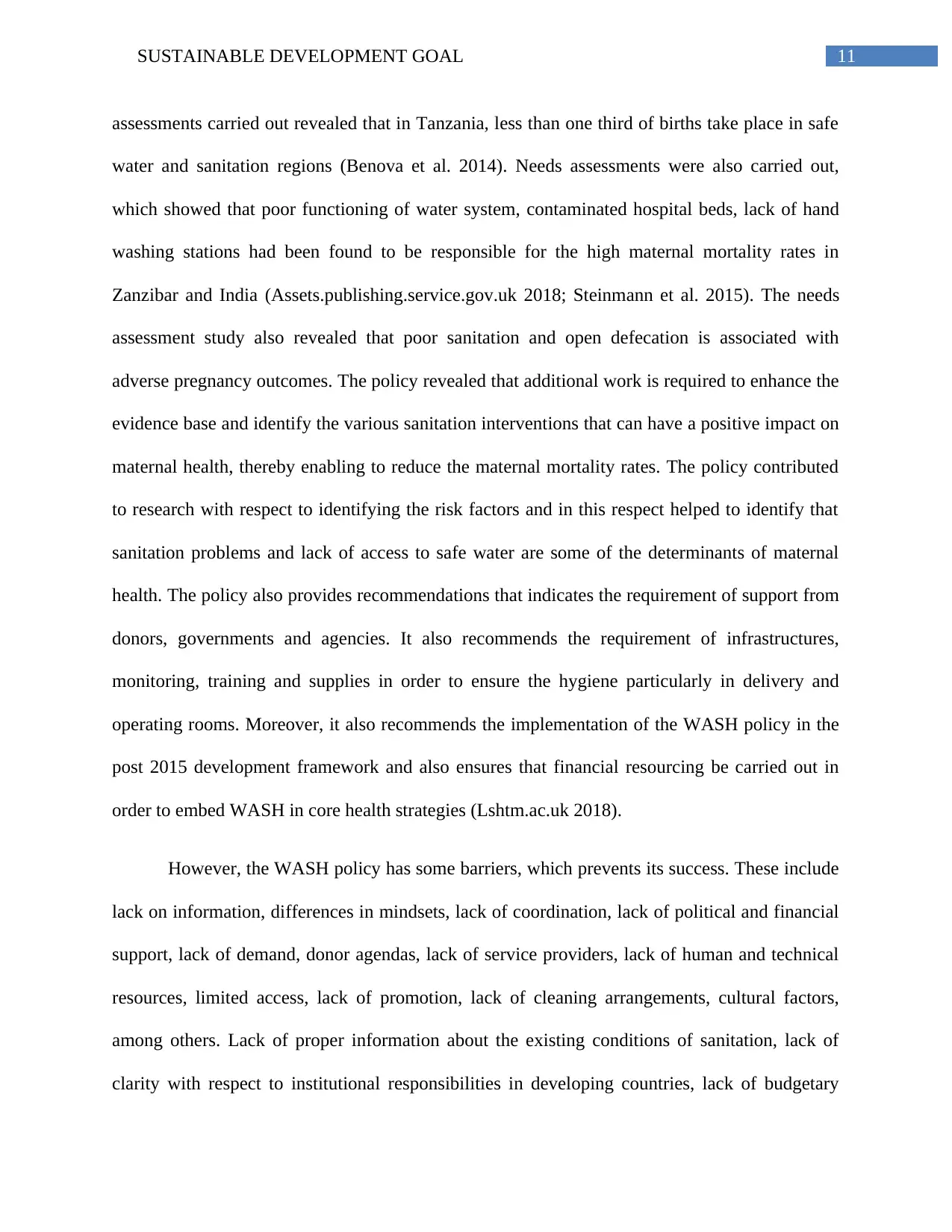
11SUSTAINABLE DEVELOPMENT GOAL
assessments carried out revealed that in Tanzania, less than one third of births take place in safe
water and sanitation regions (Benova et al. 2014). Needs assessments were also carried out,
which showed that poor functioning of water system, contaminated hospital beds, lack of hand
washing stations had been found to be responsible for the high maternal mortality rates in
Zanzibar and India (Assets.publishing.service.gov.uk 2018; Steinmann et al. 2015). The needs
assessment study also revealed that poor sanitation and open defecation is associated with
adverse pregnancy outcomes. The policy revealed that additional work is required to enhance the
evidence base and identify the various sanitation interventions that can have a positive impact on
maternal health, thereby enabling to reduce the maternal mortality rates. The policy contributed
to research with respect to identifying the risk factors and in this respect helped to identify that
sanitation problems and lack of access to safe water are some of the determinants of maternal
health. The policy also provides recommendations that indicates the requirement of support from
donors, governments and agencies. It also recommends the requirement of infrastructures,
monitoring, training and supplies in order to ensure the hygiene particularly in delivery and
operating rooms. Moreover, it also recommends the implementation of the WASH policy in the
post 2015 development framework and also ensures that financial resourcing be carried out in
order to embed WASH in core health strategies (Lshtm.ac.uk 2018).
However, the WASH policy has some barriers, which prevents its success. These include
lack on information, differences in mindsets, lack of coordination, lack of political and financial
support, lack of demand, donor agendas, lack of service providers, lack of human and technical
resources, limited access, lack of promotion, lack of cleaning arrangements, cultural factors,
among others. Lack of proper information about the existing conditions of sanitation, lack of
clarity with respect to institutional responsibilities in developing countries, lack of budgetary
assessments carried out revealed that in Tanzania, less than one third of births take place in safe
water and sanitation regions (Benova et al. 2014). Needs assessments were also carried out,
which showed that poor functioning of water system, contaminated hospital beds, lack of hand
washing stations had been found to be responsible for the high maternal mortality rates in
Zanzibar and India (Assets.publishing.service.gov.uk 2018; Steinmann et al. 2015). The needs
assessment study also revealed that poor sanitation and open defecation is associated with
adverse pregnancy outcomes. The policy revealed that additional work is required to enhance the
evidence base and identify the various sanitation interventions that can have a positive impact on
maternal health, thereby enabling to reduce the maternal mortality rates. The policy contributed
to research with respect to identifying the risk factors and in this respect helped to identify that
sanitation problems and lack of access to safe water are some of the determinants of maternal
health. The policy also provides recommendations that indicates the requirement of support from
donors, governments and agencies. It also recommends the requirement of infrastructures,
monitoring, training and supplies in order to ensure the hygiene particularly in delivery and
operating rooms. Moreover, it also recommends the implementation of the WASH policy in the
post 2015 development framework and also ensures that financial resourcing be carried out in
order to embed WASH in core health strategies (Lshtm.ac.uk 2018).
However, the WASH policy has some barriers, which prevents its success. These include
lack on information, differences in mindsets, lack of coordination, lack of political and financial
support, lack of demand, donor agendas, lack of service providers, lack of human and technical
resources, limited access, lack of promotion, lack of cleaning arrangements, cultural factors,
among others. Lack of proper information about the existing conditions of sanitation, lack of
clarity with respect to institutional responsibilities in developing countries, lack of budgetary
⊘ This is a preview!⊘
Do you want full access?
Subscribe today to unlock all pages.

Trusted by 1+ million students worldwide
1 out of 22
Related Documents
Your All-in-One AI-Powered Toolkit for Academic Success.
+13062052269
info@desklib.com
Available 24*7 on WhatsApp / Email
![[object Object]](/_next/static/media/star-bottom.7253800d.svg)
Unlock your academic potential
Copyright © 2020–2025 A2Z Services. All Rights Reserved. Developed and managed by ZUCOL.





